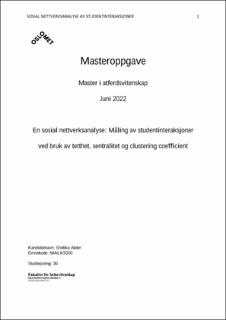En sosial nettverksanalyse: Måling av studentinteraksjoner ved bruk av tetthet, sentralitet og clustering coefficient
Master thesis
Published version
Permanent lenke
https://hdl.handle.net/11250/3019075Utgivelsesdato
2022Metadata
Vis full innførselSamlinger
Sammendrag
Social network analysis (SNA) is a process in which relationships between actors in a social network are mapped and examined. For many, school is such an arena where socialization takes place and where students develop friendships and networks. Due to the closure of schools and universities as a result of the COVID-19 pandemic, millions of students around the world were affected. The intrusive restrictions shut down all social life and normal life for a long period of time. This study aims to identify students' networks and investigate how social network analysis can be used to study the interaction between students from the same class. SNA was used to examine the density, eigenvector centrality and clustering coefficient of the actors in different network structures. A class of nine students was invited to respond to a questionnaire sent out by e-mail. The social network data from this class was analyzed using the software UCINET 6. Results showed that the students’ network were more densed in the classroom than it was outside the classroom. They were less divided into clusters in the classroom, but at the same time they communicated less with their fellow classmates when experiencing problems with lectures, syllabi and assignments. It is discussed how students possibly seek more help from the teacher than from their fellow classmates when problems with school-related matters arise. It would be of interest with further studies on whether this is the case, for example by examining how big a role and influence the teacher has on the class.
